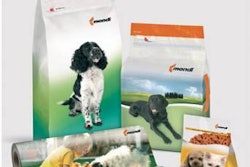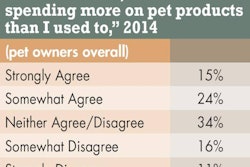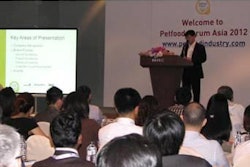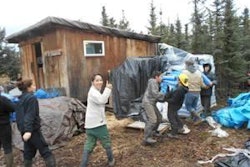We live in a society where everybody is aware of the need to control energy costs, whether this be a reduction in packaging, driving less miles per week or simply turning down the home heating a couple of degrees. In the petfood industry, where we use very large amounts of energy, we are all aware of energy costs and we all factor these costs into the price of our products. With the combination of ever increasing unit energy costs and public and legislative pressure to reduce these costs in terms of declared carbon footprint for finished products, now is the time to create and use a strategy to measure and minimize these costs. Note that virtually all of the major retail chains have made commitments to drastically slash carbon footprint for their own operations within the next few years, with a parallel target of adding a carbon label to all of their products. It is in our interests as an industry to tackle these issues urgently, but at the same time formulate strategies that allow us to compare our energy and carbon footprint costs with achievable targets for reduction. This article will look first at the way an overall strategy can be built to measure direct energy costs, then move on to study as a model the more specific area of the extrusion/drying line, and the techniques that we might employ to reduce energy costs in this high energy area of our factories.
Setting the Basic Strategy
Organizations vary in complexity, and what might be quite a suitable approach for a very large company with many resources will prove to be much too complex and expensive for smaller companies. The basic approach for all is similar, however. In fact a unified method of approaching the subject is to be recommended, to prevent fragmentation of standards and techniques. The first issue with any one company is to ensure that the project is fully endorsed by all of the key decision makers, starting at the top. One senior person is normally designated as Energy Manager. For smaller companies this can be an existing manager. There will almost always be a need to bring in support from outside the company, usually in the form of consultants with the appropriate specialist skills and knowledge. The company need not rely on any one organization, as there will be a lot of expert help available from existing suppliers, as in areas of steam generation and transmission, compressed air, chillers and HVAC.
Next step is to define the overall scope of the project. This may be a very simple objective defining targets for energy reduction or may be much more complicated, covering corporate ambitions to achieve ISO 14000 Environmental Management Accreditation. Scope should also be clear about geographical objectives. Corporate ambition will be driven by resource limitations and perceived opportunity for savings.
At this early stage identify and clarify the methodology to be used. Like all projects, Poor Planning Produces Pretty Poor Performance (5 P's), so initial planning should be thorough. There are plenty of resources available from public sources that can help. Use the Web to check federal, regional and state resources. These will help with advice on implementation strategies, advice on any financial assistance available and advice on regulatory issues. Some of these are listed in the reference appendix to this article. Also study models of strategies used by companies around the world. Unlike many corporate strategies, companies appear eager to publish their energy/carbon footprint/green house gas (GHS) reduction plans. There are some very elegant documents that can help a lot in the planning process.
Implementation
The central cycle of events is characterized in the following Steps. Note that this simplifies the management function but reinforces the following rules:
- Plan - and re-plan before running out and doing anything
- Measure - consumption before acting
- Action - make changes where required to improve performance
- Validate - the beneficial effects of the changes
Step 1 - Look at Overall Consumption or Bulk Values
These can be reported as gross cost per site or proportioned in several ways; the most usual being cost per unit of product, expressed either as monetary value of product or as weight. Expression as cost per weight of product is more convenient from the point of view that historical comparisons can easily be made as the project progresses, especially where external influences produce large changes in product pricing. From a commercial point of view, however, energy costs as a proportion of product value is very important. When figures are later broken down per product or per product group this is especially important when looking at added value products in comparison to high volume low margin products. The potential actions that may have come out of the early planning process may have produced a list like the one shown below:
Energy saving products supplied by commercial companies:
Lighting & lighting controls
Energy insulation services
Inverter controls
Motor controls
Rainwater harvesting systems
Infra-red taps
Push taps
Shower controls
Urinal controls
Flow restrictors
WC controls
Electronic water conditioners
Solar panels (electricity generators)
Solar panels (water heaters)
APM (Automated Process Management)
Natural light options
Heat exchangers
This list has been drawn from several sources and represents the typical range of services offered for energy cost reduction. If the bulk figures can at all be used to look at usage in specific areas it may be possible to immediately start looking at some sensible and obvious money-savers, such as low energy lighting, 'smart' lighting, infra-red light switch sensors, etc. On the other hand, where resource is limited or has more focus, it may be decided to initially look at high energy users in the company. This balance of expenditure against budget against pay-back needs to be carefully considered. Note that in different countries there are financial incentives, such as Enhanced Capital Allowance Schemes to allow full capital cost to be recouped out of profits in the year following the expenditure. Check carefully, as regional variations are wide and care must be taken to exist in approved technologies.
Measuring
An important tool before starting detailed measurement or committing investment to what can be expensive instrumentation is to map out the process. This can be in the form of block flow diagrams, plan maps of the facility or a process flow chart of the plant.
Use the mapping diagrams of the process to identify key points of energy measurement. It is a good exercise to measure no-load and full load power consumption of all electric motors, but at the very least target the large motors with the most potential for savings. A minimum list of measured inputs for a process flow chart is shown below:
Energy Measurement for Petfood Extruder/Dryer
1. Extruder Main Drive Motor
2. Pneumatic Conveying Fan Motor
3. Dryer Exhaust Fan Motor
4. Dryer Recirculation Fan
Motors
5. Cooler Exhaust Fan Motor
6. Conditioning Steam Flow and Pressure
7. Conditioning Water Flow &
Temperature
8. Dry Feed Rate
9. Oil/Fat Feed Rate
10. Extruder Injected Steam Flow Rate and Pressure
11. Extruder Barrel Cooling Water Flow Rate and
Temperature In & Out
12. Product Moisture into Dryer
13. Product Moisture out of Dryer
14. Dryer Recirculating Air Temperatures
15. Dryer Exhaust Air Flow Rate, Temperature, Humidity
16. Dryer Make-Up Air Temperature and Humidity
17. Dryer Gas/Steam Consumption
18. Digest Feed Rate
19. Product Feed Rate & Temperature out of Cooler
Also have product samples thoroughly tested for quality characteristics, as these will be used later for comparison.
This list already makes the project look complicated, but many plants now have proportioned control for all ingredients, which gives a lot of the information required. There may be the need to install some permanent metering and use mobile metering for some motors, but for many plants payback can be achieved even before energy saving measures are introduced. Note that care needs to be taken when selecting instrumentation. As an example, use watt meters that can take power factor into account, and also have a high enough bandwidth to take harmonic distortions into account. A bandwidth of a few kilohertz will suffice, but take advice from suppliers and reference materials.
The ideal situation is that if the whole of the plant has all its parameters measured for every product when running under equilibrium conditions, with all the motors also measured when under 'no-load' conditions. This will then allow a snapshot view of Key Performance Indicators (KPI's) for each product. With enough accurate measurement all sorts of analysis can be carried out. The following list indicates some useful Baseline KPI's per unit of product, whether this is measured in weight or financially.
Baseline Key Performance Indicators
Total Direct Energy Costs
Extruder Specific Mechanical Energy
Extruder Total Electrical Energy
Extruder/Conditioner Specific Thermal Energy
Dryer Thermal Energy Costs per unit of product
Dryer Thermal Energy Costs per unit of water evaporated
Dryer Electrical Costs
Extruder Cooling Water Costs
Loading factors on dryer and cooler exhaust air systems
Loading factor on pneumatic conveyor
Energy cost of pneumatic conveying
Power Factor
This baseline can then be examined against known standards. A product running at low rate, for example, will have a higher extruder total electrical cost per unit, as the 'no-load' power consumption of the extruder drive motor will have to be divided into a smaller production rate. If equipment manufacturers claim 1,200-1,600 Btu's per pound of water removed then comparison can be made against these numbers. Accounts and Sales will start to get real numbers for cost of production per product, which will allow them to do costings realistically and more accurately know profitability per product.
Analysis against the Ideal Case
For the major process steps in the extrusion plant it is possible to look at the ideal calculated energy inputs, as listed below:
1. Conditioning Steam
The specific heat capacity of the dry mix can be measured or
calculated from existing data. As an example, the specific heat
capacity of wheat starch is 1.72 kJ kg -1 K -1. This means that
to warm up the wheat flour from 20 deg C to 100 deg C requires
137.6MJoules of energy or 38kWh per tonne or 118,314 Btu's per
'short' ton. This is equivalent to 51kg steam per hour injected
at atmospheric pressure. The story isn't this simple as the
steam remains in the mix at 100 degrees C (212 deg F) so the
sensible heat in the steam is not given up. The amount of added
steam then re-calculates at 60 kg/tonne (120 lbs/ton). The
calculation gets more complicated when added oil, meat and
conditioning water are introduced into the equation, especially
if the conditioning water has not been pre-heated before
addition.
The conditioning steam doesn't just warm up the materials in the conditioner. Starch cooks or gelatinizes under endothermic conditions, and the amount of energy to gelatinize starch is between 2.7 and 5.3 calories/gramme, depending on the source of the starch. Other materials undergo endothermic change, for instance when proteins cook and denature, and the total adds a few kW/tonne heat requirement to the energy input in the conditioning cylinder.
2. Conditioning Water
This either has to be heated by the steam in the conditioner
or, better, preheated before injection into the conditioner.
The specific heat capacity of water is approximately 4.2 joules
per gramme per degree Celcius, so calculation as previous can
soon figure out how much steam is required. Note that the
process balance requires that a known and controlled amount of
moisture is added to the extrudate, and this will need balance
between the various ingredients' moisture content and added
conditioning and extruder steam.
3. Extruder Steam Injection
This steam is injected at high pressure of typically 7 Bar, so
care must be taken to calculate energy input allowing for this
pressure. Levels of steam injection into the barrel are lower
than in the conditioner, typically 1-2% by mass as a proportion
of feed rate. This steam at 7 Bar pressure has a temperature of
approximately 153 degrees C (307 deg F). Calculation can be
made about the effect of adding this steam to extrudate
temperature increase. Steam injection is in the barrel before
the point at which high mechanical work is put into the
extrudate, and approximately 2% addition will increase
extrudate temperature to 120-125 deg C from 100 deg C,
depending on ingredient mix in the extrudate.
4. Drying Costs
Claims are made by manufacturers of dryers that modern dryers
remove water more efficiently, figures as low as 1200 Btu's per
pound of water removed being quoted. There are ways of
improving dryer efficiencies, but there in some cases be an
overwhelming case to replace an old dryer.
Reducing Energy Costs
The following list is a combination of strategies that have been used to reduce energy costs and/or improve rate and product quality. This list alone would take up the space of a second article, so is by necessity condensed. Note that this list sits over and above all the other savings that can be made in the factory, but illustrates the range of opportunities that exist to improve efficiencies, in some cases by up to 25%.
Ways to Improve Performance on an Extrusion Plant
Improvement Effect
Pre-warm Conditioning Water Faster hydration; quicker warm-up in
conditioner effectively increasing size of
conditioner; use less steam to warm up water
Use Misting Injector for More rapid heating; More homogenous heating;
Conditioning Steam Better absorption of steam reducing waste
Use Pulse Jet Injection for Better control of injection rates; Avoids
Conditioning Steam Ratholing giving better absorption
Pre-dampen cereal grains Removes moisture variations and improves
hydration and cook before cooking
Pre-dampen mixed powders Rapid and more homogenous heating and
hydration in conditioner before live bin
Use water from barrel cooling Avoid capital and energy expense of chillers;
as Conditioner Water or Boiler Uses extruder heat to pre-heat water
Make-Up water
Pre-heat dryer make-up air using Reduces drying costs, especially in winter
warm air from cooler or dryer in cold climates; With humidity and temperature
exhaust control on air also reduces drying variability
Increase humidity in first drying Increases heat transfer efficiency giving
using steam injection increased drying efficiency
Conclusion
This article has skimmed through the subject, but it may be seen that there are opportunities to save on energy costs in any existing plant. The opportunity for economies is highly complex and the project should be approached in a highly systematic way, ideally reflecting methodology and practices recommended by government authorities and our customer base, led by the many initiatives being introduced by the retail chains. There are many competent organizations that can help us to audit our energy costs and wider carbon footprint, but it is in our own industry that we have the skills to address the heart of our processes to minimize these costs.
.png?auto=format%2Ccompress&crop=faces&fit=crop&h=48&q=70&w=48)
















